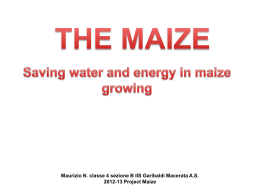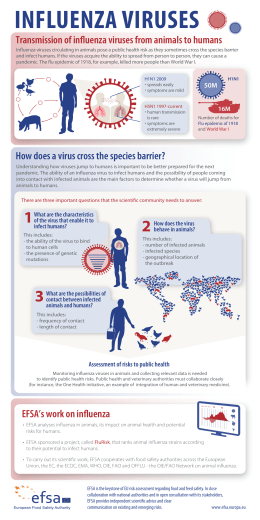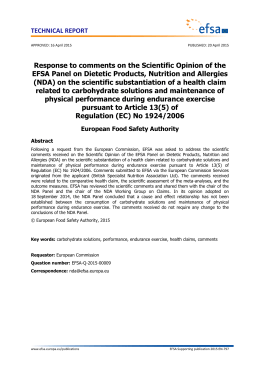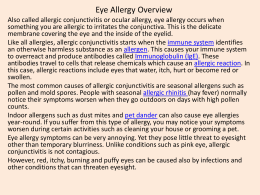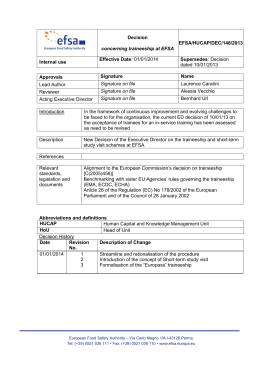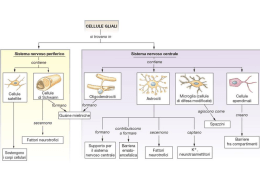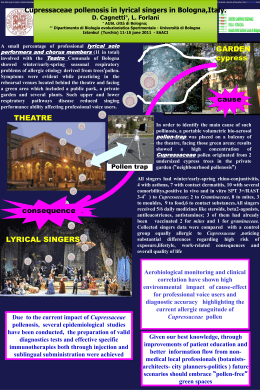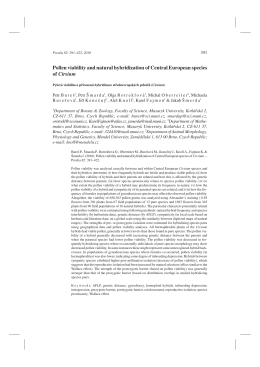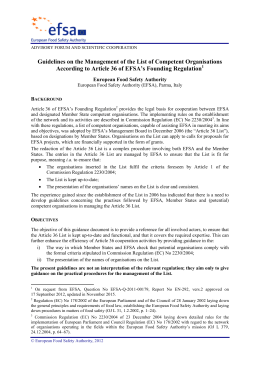Bulletin of Insectology 66 (2): 257-267, 2013 ISSN 1721-8861 Applying an operating model for the environmental risk assessment in Italian Sites of Community Importance (SCI) of the European Commission Habitats Directive (92/43/EEC) Matteo LENER1, Valeria GIOVANNELLI1, Salvatore ARPAIA2, Ferdinando BALDACCHINO2, Anna BENEDETTI3, Giovanni BURGIO4, Loredana CANFORA3, Giovanni DINELLI4, Barbara MANACHINI5, Ilaria MAROTTI4, Antonio MASETTI4, Cristiana SBRANA6, Valentina RASTELLI1, Giovanni STAIANO1 1 Department of Environmental Protection, Institute of Environmental Protection and Research, Rome, Italy 2 ENEA Research Centre Trisaia UTTRI-SSPP, Rotondella, Italy 3 Consiglio per la Ricerca e la Sperimentazione in Agricoltura - Centro di Ricerca per lo Studio delle Relazioni tra Pianta e Suolo (CRA-RPS), Roma, Italy 4 Department of Agricultural Sciences, University of Bologna, Italy 5 Dipartimento di Scienze e Tecnologie Biologiche, Chimiche e Farmeceutiche (STEBICEF), Università di Palermo, Italy 6 CNR-Institute of Agricultural Biology and Agrobiotechnology UOS Pisa, Italy Abstract The fast development of agro-biotechnologies asks for a harmonized approach in risk analysis of GMO’s releases, where “risk analysis” entails the assessment, management and communication of risk. Risk assessment consists in the evaluation of the likelihood that a hazard occurs, associated with the presence of the receptor(s) in the receiving environment, and the determination of their potential degree of exposure to the hazard. The whole process has to be both science based and applied case by case, and it involves a very complicated procedure that needs to be transformed in an operational and standardized tool. Beginning in 2003, an expert group on behalf of the Italian Ministry of the Environment elaborated an Operating Model for the Environmental Risk Assessment (OMERA) mainly addressed to scientists, companies, regulators, environmentalists, and also aiming to provide the stakeholders with a scientifically correct source of information. OMERA is based on a logic scheme, moving from the assumption that the occurring of a risk, associated to the release of a GMO into the environment, is strictly related to the presence of four elements: a) source; b) diffusion factors; c) dispersal routes; d) receptors. It comprises two main components: a conceptual model represented as a flowchart and an electronic Questionnaire (eQ) driven by a relational database (Microsoft Office Access). The eQ includes sets of questions specifically formulated for each box of the flowchart that create a “decision tree” that can be followed from the source to all the components of the conceptual model. Completing the eQ leads to the identification of the potentially affected receptors and related potential effects. Within the framework of a LIFE+ project (MAN-GMP-ITA) a multidisciplinary group was formed to validate and improve this methodology. The questionnaire has been filled simulating the release of herbicide tolerant GT73 oilseed rape and insect resistant MON810 maize in different experimental areas. The results attested that OMERA allows the collection and comparison of experimental data in a standard way and at the same time leads to the identification of receptors, potential effects and related monitoring activities specifically for the case study. The experiences described in this paper have shown the potential area of improvement of OMERA to achieve a more functional Decision Supporting System (DSS) that would give a quantitative risk evaluation and the extension to commercial fields. As for OMERA, the DSS will be user-friendly and could be easily modified and adapted to specific situations i.e risk assessment of GM crop field trials. Key words: environment, risk assessment, environmental effects, GMO, plants, genetically modified, oilseed rape, maize, Italy. Introduction In the European Union, the deliberate release of Genetically Modified Organisms (GMOs) is regulated by Directive 2001/18/EC and Regulation (EC) No 1829/2003: [Directive 2001/18/EC of the European Parliament and of the Council of 12 March 2001 on the deliberate release into the environment of genetically modified organisms and repealing Council Directive 90/220/EEC] [Regulation (EC) No 1829/2003 of the European Parliament and of the Council of 22 September 2003 on genetically modified food and feed (Text with EEA relevance)]. The Directive refers to the deliberate release into the environment of GMOs and sets out two regulatory regimes: Part B addresses the deliberate release of GMOs for any other purpose (including field trials), while Part C regulates the placing on the market of GMOs. The Regulation provides Community proce- dures for the authorization and supervision of GM food and feed, and additionally gives provisions for their labelling. While the Regulation’s objectives are food and feed, it can also be applied to the authorization of GMOs for cultivation if they are intended for food or feed use. According to the mentioned Directive and Regulation, an applicant has to perform an Environmental Risk Assessment (ERA) to obtain authorization for the release of GMOs into the environment. The objectives and principles, together with the methodology, are outlined in Commission Decision 2002/623/EC: [Commission Decision of 24 July 2002 establishing guidance notes supplementing Annex II to Directive 2001/18/EC of the European Parliament and of the Council on the deliberate release into the environment of genetically modified organisms and repealing Council Directive 90/220/EEC (Text with EEA relevance)]. The ERA is defined as “the evaluation of risks to hu- man health and the environment, whether direct or indirect, immediate or delayed, which the deliberate release or the placing on the market of GMOs may pose”. The ERA is carried out on a case-by-case basis depending on the GM plant species, concerned trait(s), their intended use(s) and the characteristics of the receiving environment(s). The ERA is to be conducted in a scientifically sound and transparent manner based on available scientific and technical data, and on common methodologies for the identification and interpretation of relevant data. The ERA process is aimed to identify and evaluate potential adverse effects of GMOs, but also to provide the basis for subsequent monitoring plans together with risk management approaches. According to the step-by-step ERA approaches developed worldwide for chemical or other environmental stressors (Hill and Sendashonga, 2003; Hill, 2005) the EU biosafety legislative framework foresees 6 steps (figure 1). On November 2010 the European Food Safety Authority (EFSA) published its latest Guidance Document on the environmental risk assessment of genetically modified plants (EFSA GMO Panel, 2010). The Guidance Document represents a large effort to summarize and organize the operational procedures for conducting a comprehensive ERA on GM crops. This document discusses the six steps of ERA on Genetically Modified Plants (GMP), as reported in the Commission Decision 2002/623/EC, giving a comprehensive interpretation of each step and addressing seven specific areas of possible concern. The EFSA document represents updated guidelines on data requirements for ERA and includes several general cross-cutting considerations (e.g. choice of comparator/s, receiving environments, statistical approaches, long-term effects). In the first step of ERA, which includes the Problem Formulation, the assessor has to scope out the problem by determining the main target of the assessment and the information needed (Yang et al., 2009; EFSA GMO Panel, 2010; Wolt et al., 2010) The starting point of this step is the characterization of hazards through a comparative safety assessment that would allow the identification of any biologically relevant differences between the GM plant and its conventional counterpart that may lead to harm. Subsequently, it is necessary to identify the exposure paths through which the GM plant may adversely affect the receiving environment. Finally, the identified potential adverse effects need to be linked to assessment endpoints (i.e., natural resources or ecological functions and ecosystem services representative of the Protection goals), in order to derive testable hypotheses allowing quantitative/qualitative evaluations. According the European framework the risk (Risk characterization, step 4) is estimated combining the likelihood of exposure, (Exposure characterization, step 3) with the magnitude of associated effects (Hazard characterization, step 2). In the final step (overall Risk evaluation and conclusions), the overall risk covers each risk and the relevant management strategies (Risk management strategies, step 5). The complex legislative process and the rapid development of agro-biotechnologies require harmonized and operative approaches in risk assessment of GMO’s applications. At the Member State level an important contribution can be given by specific knowledge of the local receiving environment developed for supporting ERA. Figure 1. The six steps of the ERA according to EFSA Guidance on the environmental risk assessment of genetically modified plants (EFSA GMO PANEL. 2010). 258 Within the framework of a LIFE+ project named “Validation of risk management tools for genetically modified plants in protected and sensitive areas in Italy” (LIFE MAN-GMP-ITA) a multidisciplinary group was formed to validate and improve an existing ERA methodology (Sorlini et al., 2003) to perform ERA on GM plants, and to address the requirements of the European legislative framework on GMOs. Our goal was to develop an operative Decision Support System for Assessors and Managers involved in GMOs release evaluation. The methodological proposal Operating Model for the Environmental Risk Assessment (hereinafter OMERA), is a tool to perform a risk assessment applied to GM crops field trials, that can be used by different assessors including applicant, competent authorities and other stakeholders. The system represents and describes the complex relationships between environmental receptors and the harmful characteristics of a GM crop in the field. Furthermore it leads to the identification of potential environmental effects on a case by case base. The main aim of the present paper is to outline the logic of OMERA illustrating its keys features with the help of practical and concrete (real) examples applying it to different scenarios. In these scenarios the presence of GM oilseed rape and maize crops is simulated. Materials and methods OMERA OMERA comprises two main components: a conceptual model represented as a flowchart (figure 2) and an electronic Questionnaire (eQ) driven by a relational database (Microsoft Office Access) (http://bch.minambiente.it/EN/Biosafety/propmet.asp). OMERA identifies questions to be answered to conduct a ERA process on a case by case base, it gives a list of potential impacts related to the case study. It allows the visualization of the potential pathways from a source of risk to potential impacts to the environment. The flowchart represents the possible relations between a GM field trial and the receiving environment. It is based on the assumption that the occurrence of a risk is strictly related to the presence of four elements and of their interrelationships: Source; Diffusion Factors; Dispersal Routes; Receptors. The Source is where the organism is released and/or enabled to express its potential harmful characteristics. The Diffusion Factors are linked to the biological features of the GMP (e.g. pollen, seed). Dispersal Routes are the chemical, physical, and ecological characteristics of the receiving environment involved in the dispersal. Receptors are components of the ecosystem (including humans, animals, other plants, etc.) that may be affected by the Source. Figure 2. Conceptual model representing the potential relations between GMP in a field trial and the receiving environment. 259 The eQ includes sets of questions specifically formulated for each box of the flowchart that create a “decision tree” that can be followed from the source to all the components of the conceptual model. Completing the eQ leads to the identification of the potentially affected receptors and related potential effects. The eQ includes two kinds of question sets: the first group of questions is descriptive and they reflect the information required in the Annex III of the Directive 2001/18/EC. The second type of questions trigger a yes/no/don’t know answer that can open or close specific paths. According to a precautionary approach, if a “don’t know” answer is given, highlighting a lack of knowledge, the system automatically selects the path that represents the worst-case scenarios. The first set of questions enables the characterization of the source. These questions consider: - the biological characteristics: full name, biological form, leaves and stem, root system, fruit, seed, duration of vegetative cycle, infesting and invasive capacity; presence/absence of any toxins, and antinutrients and/or allergens present in the host plant, with the conventional counterpart taken as the baseline for each characteristic; - the genetic modification: introduced or modified genes, transformation stability, expression of the insert, number of insert copies, insertion site, unin- tended inserted sequences, origin of inserted material; - the conditions of the release: location of release site, farm size, release area size, size of area cultivated with GMP, release duration, release period, cultivation practices. Once the characterization of the source has been completed, different sets of key multiple choice questions (yes, no, don’t know) can activate or block specific DFs: pollen, seed, crop residues, plant organs or parts (figure 3). The next step is the characterization of the activated DFs where the descriptive set of questions refers to the biological attributes of the crop and the environmental factors influencing them. Field management practices are taken into account in this step as well. These questions are useful for exposure characterization. For each activated DFs specific DRs are identified and described, including those acting on the exposure level and mitigation measures DRs (figure 2); include atmospheric factors, insects or other animals, agricultural practices, etc., and represent the routes that lead DFs to specific receptors. Once the DFs and DR has been assessed, the questionnaire seeks data on the presence or absence of related receptors at reachable distances and of harmful new characteristics in the GMP DFs. Figure 3. Flowchart resuming an example of key multiple responses questions activating the pathways related to the DF Pollen in the analyzed oilseed rape case studies. In this specific example the activated Dispersal Routes are Atmospheric Factors and Insects. 260 Hybridization between the crop plants and sexually compatible plants near the field can produce viable seeds that if dispersed into the environment could lead to potential indirect effects. For this reason, the receptor Compatible Plants is considered a Secondary Source of risk. This source is split into three sub-groups: GM crops, non-GM crops, and wild sexually compatible species. GM crops are maintained in a separate group because the cross-fertilization with different GM events would lead to specific effects related to the occurrence of stacked genes. OECD (OECD, 1997, 2001, 2003, 2007). Bibliographic sources were also used to complement field observations, in particular those on climatic and soil characteristics, and functional biodiversity. The eQ has been applied in five Sites of Community Importance (SCI) from the European Commission Habitats Directive (92/43/EEC) in Italy: two in Emilia Romagna, one in Lazio, one in Basilicata and one in Sicily. Non-GM fields of oilseed rape and maize were cultivated in the selected areas (table 1) to provide details about the crop-environment interactions at each location. Questionnaire responses To test the process, the questionnaire was completed independently by four different groups of experts, one for region, from the consortium of the Life+ project. It was compiled simulating the presence in the field of herbicide tolerant GT73 oilseed rape and insect resistant MON810 maize. Both these events are already authorized under Directive 18/2001/EC, thus most of the information requested in the questionnaire related to the molecular and botanical characteristics of the crops is available in the EU register of GM products (http://ec.europa.eu/food/dyna/gm_register/index_en.cfm) established in accordance with the Regulation (EC) 1829/2003 and in related documents like the Summary Notification Information Formats (SNIFs), the EFSA opinions, and the Consensus documents edited by Field trials Oilseed rape fields The same experimental layout was prepared in three different locations during the 2011 growing season: SCI IT4050001 (Gessi bolognesi e Calanchi dell'Abbadessa), SCI IT6030015 (Macchia di Sant’Angelo Romano), SCI IT9220090 (Costa Ionica and Foce Bradano). The experimental designs of the three sites were arranged for both short-distance (1-20 m) and long-distance pollen (50-500 m) dispersal studies, as defined in the literature (Scheffler et al., 1993; 1995; Funk et al., 2006). The oilseed rape (Brassica napus L.) varieties used in the field trials were the free-pollinating “Ceres” and “Dante” cultivars, respectively selected as donor and receiving crops, where the donor simulates the GM crop. The donor plot was surrounded by eight receptor plots. Table 1. Sites of Community Importance, area description. Region / Name Surface EU protection (ha) status Short description Crop The area is a humid coastal area rich of different habitat types, it is particularly vulnerable due to the coastal erosion and the peculiar climatic pSCI NATURA Maize, conditions. It is therefore very important the monitoring of any human 2000 Code: oilseed activity for its potential effect on the area. The area of the SCI is for 50% IT9220090 rape public property and 50% private. Main land uses are agriculture (30%), touristic activities (20%), urban (5%) and conservation (45%) The fragmented site comprises rural areas and is in particular is surEmilia-Romagna / SPA and pSCI rounded by arable crops, it is is 100% private property, including 5% of Bentivoglio, NATURA 2000 channels. Three areas of community interest cover about 14% of the site: Maize S. Pietro in Casale, 3224 Code: - natural lakes with community plants of Magnopotamion or HydrochariMalalbergo e IT4050024 tion; margin rivers with plant communities of Chenopodion rubri and Baricella Bidention; and forest of Salix alba and Populus alba The crops are common on most of site (arable crops, vegetable crops, fruit orchards). The area is for 90% of private ownership and 10% of pubEmilia-Romagna / pSCI NATURA lic ownership (Parco dei Gessi). The woods are present on 14% of the Gessi Bolognesi, Oilseed 2000 Code: site. The grass-lands cover about 25% of the area. The site is included 3965 rape Calanchi IT4050001 (86%) within the “Regional Park of Gessi Bolognesi and Calanchi dell’Abbadessa dell'Abbadessa”. Eleven habitat included within the Habitats Directive cover about 45% of the area The site has an important role for many species of plants and animals of pSCI X particular naturalistic value. Macchia di S. Angelo Romano is an imporLazio / Maize, NATURA 2000 tant halting area for several migratory birds of Community Interest. The oilseed Macchia di S. 798 Code: SCI area is not particularly vulnerable but the monitoring of any human rape Angelo Romano IT6030015 activity is important. Main land uses are agriculture (15%), urban and industrial (5%), woods (30%), water bodies (5%) and conservation (45%) The area includes mountains as well coastal agricultural and urban areas. Sicily / SIC ZPS The site has an important role for many species of plants and animals of Raffo Rosso, NATURA 2000 particular naturalistic value and endemic species. The site includes habiMaize 6098 Code: tat from which several species where used for their characterization. Main M. Cuccio e ITA020023 land uses are grassland and steppes (70%), heath (15%) and woods (5%) Vallone Sagana but also agriculture and tourist activities Apulia Basilicata / 473 Costa Ionica Foce Bradano 261 Maize fields For the maize field, four different locations were planted during the 2011 growing season: in Emilia, the maize field was approximately 6 hectares and located near SCI IT4050024 - Biotopi e Ripristini Ambientali di Bentivoglio, San Pietro in Casale, Malalbergo e Baricella. In Lazio the field study, approximately two hectares, was carried out at the experimental farm of the Agriculture Research Centre at about two kilometers of the protected area SCI IT6030015 (Macchia di Sant’Angelo Romano). In Basilicata the research activity was conducted on a maize field of approximately one hectare, at the experimental farm “Pantanello” located approximately one kilometre from the protected site SCI IT9220090 (Costa Ionica - Foce Bradano). In Sicily the maize field was approximately 0.8 ha at the experimental farm and located less than one kilometre the protected site SCI ITA020023 (Raffo Rosso, Monte Cuccio e Vallone Sagana). Results The five study areas are representative of the potential Italian “receiving environment” for the chosen GMP species, in terms of environmental conditions, cropping systems, biocoenosis, and relevance of surrounding habitats. At least one field of the two crops (oilseed rape and maize) was grown at each site, except for the site in Sicily where only maize was grown. Thus seven different risk scenarios have been analyzed and seven diverse questionnaires have been compiled. In the ERA procedures, the characteristics or biology of the parental plant are important sources of information because knowledge of the biology of the comparator plant provides baseline information suggestive of the likely behaviour of the transgenic plant in the environment into which it is introduced. The first section of the eQ questions corresponds to a comparative analysis to establish if the GMPs show the same characteristics as the parental line used as comparator. The questions identify the botanical and agronomic characteristics of the GMP, together with the molecular characterization of the inserted genes and the insertion site in order to identify intended and potential unintended effects. The transgenes considered in this study are integrated as a single copy in the plant genome. In oilseed rape GT73, the GOXv247 and CP4 EPSPS proteins are constitutively expressed, both conferring tolerance to glyphosate-based herbicides; while in maize MON810 the CRY1Ab insecticidal protein is constitutively expressed. Filling in the questionnaires using data and information presented in EFSA opinions for oilseed rape (EFSA GMO Panel, 2004) and maize (EFSA GMO Panel, 2009), no unintended effects linked to the new molecular characteristics have been reported. Pathway for pollen and seed DFs Figures 4 and 5 show the activated pathways for the oilseed rape and maize field trials related to pollen and seed DFs and corresponding receptors. In all cases pol262 len and seeds will be produced and dispersed, but different receptors are present. Reviewing the questionnaire responses, the oilseed rape pollen will be produced but according to the EFSA opinion (EFSA GMO Panel, 2004) no allergenic or toxic compounds are expressed in pollen grains, thus the pollen route to human and other consumers’ receptors is closed. By contrast, the pathway leading to compatible plants is activated. The presence of wild compatible species in all the three sites has been observed and, according to the experimental design, cultivated oilseed rape is present at distances reachable by pollen; for these reasons potential effects on the rural environments and natural habitats receptors through specific interbreeding can be hypothesized. In this case risks should be evaluated considering frequency of the gene flow and the ecological role of the resulting offspring. The system then follows the fate of viable F1 seeds produced in the GM field; as shown in figures 4 and 5 they can be dispersed by diverse DRs reaching rural and natural environment receptors. However considering the GM oilseed rape phenotype, potential effects have been hypothesized only in rural environments. Indeed oilseed rape is considered a weed species but not invasive (OECD, 1997); the herbicide resistance characteristic conferred by the transgenes would cause enhanced persistence in field and field margin of the resulting offspring. Compared to the oilseed rape cases, the maize case studies present important differences in activated pathways (figures 4 and 5), depending on botanical and ecological characteristics of the crop and on the characteristic of the inserted transgene. As a Bt maize release has been hypothesized, the presence of toxin Cry1Ab in pollen grains actives the pathway leading to the receptor consumers, which would include both target and nontarget Lepidoptera feeding pollen maize. The resulting potential effects identified drive the system to ask for the characterization of the target and nontarget Lepidoptera populations present in the sites during the GM release. The Secondary Source Compatible Plants pathway is not activated, for either cultivated or wild plants. Indeed, at distances reachable by the pollen, maize crops are not cultivated and wild relatives of maize crop are not present in Europe. As a result no potential effects on rural environment and natural habitats due to vertical gene flow can be identified. F1 seeds could be produced only within the experimental fields. Due to the specific agricultural conditions within the three maize case studies, some differences in the DF F1 Seed are reported. In fact, in Basilicata field trial maize is harvested before seeds mature, thus the pathway that leads to DF Seed is blocked. Where F1 seeds are produced, no effects can be hypothesized for the natural and rural environment receptors, because maize is neither invasive nor weedy (OECD, 2003). In addition, maize cannot survive outside the field in Italian environmental conditions. The CRY toxin is present in seed too, but the presence of CRY-sensitive organisms feeding on maize seeds as a major food source was considered unlikely, hence the pathway to the receptor consumers of seed is closed. Figure 4. Flowchart showing the activated pathways in relation to the three oilseed rape field trials. The non activated items are transparent. Figure 5. Flowchart showing the activated pathways for maize case studies. The non activated items are represented by dotted lines or transparent. 263 Pathway for cultural residues and plant organs DFs Even if oilseed rape and Maize case studies show the same results (figures 4 and 5), these results are obtained by different kinds of responses. In fact, where for the maize case the diverse eQ pathways are activated by affirmative answers, for the oilseed rape case the experts have given several “don’t know” responses. For example, to the question, “Are there any new substances or proteins in the GMP root exudates?” in the maize case the answer was “Yes,” as reported in diverse studies on maize MON810 where Bt toxin in root exudates has been identified (Saxena et al., 2004). In the oilseed rape case root exudates, also in relation to the inserted gene product, have not yet been investigated, consequently the answer in questionnaire was “don’t know.” As described above, the software considers this lack of knowledge as a source of risk and opens the potential pathways representing the worst case scenario and therefore resulting in the same list of potential effects (tables 2 and 3). Monitoring actions should be set up to verify the occurrence of the hypothesized effects. In maize case diverse potential effects on non-target organism populations have already been studied, but only in laboratory and microcosm studies, representing a worst scenario, some effects have been identified (Zwahlen et al., 2003; Brusetti et al., 2004; Castaldini et al., 2005; Kramarz et al., 2009), while in other researches no one has been reported (Saxena and Stotzky, 2001a; 2001b; Griffiths et al., 2006; Vercesi et al., 2006; de Vaufleury et al., 2007; Verbruggen et al., 2012). For oilseed rape tolerant to herbicides no specific studies have been performed yet. Identified effects The complete list of the identified potential effects for each receptor for oilseed rape and maize case studies is shown respectively in tables 2 and 3. As indicated in the tables, some of the effects are direct results of the interaction between DFs and Receptors, while others depend on the consequences of this interaction. It is important Table 2. List of the Identified Potential effects (column 1) versus receptor (row 1) for the three case studies of oilseed rape. The activated Diffusion factors are specified together with the distinction in direct (D) and indirect effect (I). Natural habitats Rizosphere and symbionts Potential changes to agrobiodiversity Pollen (I) Pollen (I) Seed (I) Residues (D) Potential changes to edaphic fauna biodiversity Potential changes to GMP development Potential changes to GMP productivity Potential changes to rhizosphere abiotic component Plant (I) Plant (I) Plant (I) Pollen (I) Seed (I) Residues (I) Pollen (I) Seed (I) Residues (D) Potential changes to soil fertility Potential changes to soil microbe and fungal biodiversity Potential changes to structure of microbial and fungal rhizosphere populations Potential changes to structure of nonsymbiotic populations Potential changes to structure of rhizosphere populations Potential changes to structure of symbiotic populations Potential colonisation of natural habitats Plant (D) Plant (D) Plant (D) Plant (D) Pollen (D) Pollen (D) Seed (I) Seed (D) Potential food chain contamination Potential increase of weeds Potential pollution of natural genetic resources Potential uncontrolled GMP presence in the environment 264 Soil Pollen (I) Seed (I) Pollen (I) Seed (I) Potential changes to agricultural practice Potential changes to biodiversity Rural environment Pollen (I) Pollen (I) Seed (D) Table 3. List of the Identified Potential effects (column 1) versus receptor (row 1) for the four case studies of maize. The activated Diffusion factors are specified together with the distinction in direct (D) and indirect effect (I). Consumers Potential allergenic effects on population Potential allergenic effects on workers Potential changes to edaphic fauna biodiversity Potential changes to GMP development Potential changes to GMP productivity Potential changes to rhizosphere abiotic component Potential changes to soil fertility Potential changes to soil microbe and fungal biodiversity Potential changes to structure of microbial and fungal rhizosphere populations Potential changes to structure of nonsymbiotic populations Potential changes to structure of rhizosphere populations Potential changes to structure of symbiotic populations Potential changes to target pathogen host range Potential development of resistant target pathogen populations Potential effects on biodiversity Toxicity potential for consumers of new substances in pollen Men Plant pathogens Rizosphere and symbionts Soil Pollen (D) Pollen (D) Residues (D) Plant (I) Plant (I) Plant (I) Residues (D) Residues (D) Plant (D) Plant (D) Plant (D) Plant (D) Plant (I) Plant (I) Pollen (I) Pollen (D) to note that potential effects are not risks; they should be evaluated for their probability and consequences in order to complete the risk assessment. The same effect can occur via different DFs (tables 2 and 3). In the oilseed rape case studies the indirect potential changes to agricultural practice on the rural environment receptor is due both to pollen and seed DFs. Again, on the same receptor, the potential food chain contamination derives from pollen and seed dispersal, but in this case the first is a direct effect, while the second one is indirect. Indeed, the pollen produced by the GM field can pollinate the neighbouring compatible fields, while oilseed rape seeds can be dispersed into the rural environment by animals, wind, or other vectors, becoming weeds in cultivated fields and potentially contaminating oilseed rape crops in the following seasons. Similarly, for the soil receptor some of the identified potential effects, such as the potential changes to soil fertility, are consequences of other effects: see the potential changes to soil microbe and fungal biodiversity and the potential changes to agricultural practices. Comparing the lists of the identified effects in the questionnaires, a unique difference can be identified only in one of the oilseed rape case studies. It can be observed for the rural environment receptor in relation to seed dispersal; this result is due to a specific rural environmental characteristic in the Basilicata region where oil- seed rape is not normally cultivated and thus no cultivated oilseed crops are present. The identified potential effects related to the soil receptor are the same in all the case studies. Potential effects do not depend on soil characteristics, but are essentially due to lack of information on changes in bromatological composition of plant residues. The occurrence of effects can be assessed with targeted monitoring activities. Discussion and conclusion Environmental risk assessment of GM crops is performed to evaluate whether any harm might arise from the deliberate release of a genetically modified plant into the environment. It is generally based on information on the characteristics or biology of the unmodified parental plant, the trait(s) engineered and the resulting phenotype, the characteristics of the receiving environment, the intended use, and the interaction among these factors (EFSA GMO Panel, 2010). The ERA, within the framework of the relevant legislation, establishes the context for identification of: - potential hazards that might be associated with the transgenic plant; - aspects of the receiving environment that might be harmed by the identified potential hazard; 265 - the attributes of the receiving environment that may need protection; - pathways by which the identified potential hazard might move beyond the environment of cultivation; - information, from existing literature or new studies, needed to evaluate the probability that the hazard might exert an effect and that harm might occur and to evaluate the magnitude of any such harm; - targeted risk management strategies based on the outcome of the risk characterization. OMERA has been confirmed as a useful tool performing the different steps of ERA. The implementation of OMERA gives a list of potential effects and related receptors, allows the visualization of the pathways starting from the source, going through dispersal routes and diffusion factors, and reaching the potential receptors. It also helps to identify data and information necessary to evaluate the likelihood of the identified effects. It provides a clear picture of the relation between the source of harm and receptors, giving assessors an easy and unequivocal opportunity of carrying out causes and effects analyses. In addition, the visual representation will allow the identification of hot spots that should be considered during risk management procedures, using the diagrams represented in figures 4 and 5, and would help in identifying points where containment and management measures could be adopted. For example, the presence of maize pollen in a small field trial could be managed by detasselling the flowers or increasing the distance from compatible crops to avoid crop contamination. In the case of oilseed rape, to reduce the probability of the occurrence of the identified potential increase of weeds, crop rotation practices could be applied together with the use of an alternative, non-glyphosate herbicide. In case of field trials, monitoring activity and manual uprooting could be another option. It is useful to stress that the proposed model can be applied both ex ante and ex post release: in the ex ante phase to identify potential effects, in the ex post release phase to select risk management procedures, to set up monitoring activities, and to verify the success of the risk management procedures applied. OMERA can be considered a Decision Support System not only for the elaboration of risk hypotheses and the establishment of monitoring programs, but also for the selection of the most effective management strategies. Due to its characteristics it can be used by different of risk assessors, competent authorities, organisations. As further auxiliary application, OMERA could be considered as training tool for beginners assessors, also to elicit their opinion. The experiences described in this paper have shown one potential area of improvement of OMERA to achieve a more functional DSS. Most of the questions related to botanical and agronomical characteristics are already well established in official documents (i.e. OECD publications “Series on Harmonization of Regulatory Oversight in Biotechnology”: Consensus Documents on the biology of etc.) and this information is necessary for any ERA. Given this initial assumption, it is clear that this kind of information could be gathered in a database as a whole file that would automatically be 266 used in the DSS. The same procedure could be adopted for well-known transgenes. In this way the user would only be asked to complete the questions related to the case specific characteristics such as those relating to the site, including soil and climatic characteristics. A standardized procedure in performing ERA and in collecting data would improve information sharing and risk communication on GM plants for all stakeholders, including the general public. This method will lead to a common risk assessment, where all the relevant system components are taken into account. The structure and contents of the methodology can be easily adapted and implemented to different situations. New questions can be edited to focus on a specific receptor, for example insects to be used as bio-indicators; or to stress a particular topic (e.g. bioremediation). At the same time the conceptual model can be developed starting from different sources of harm (e.g. transgenic insects or microorganisms). Acknowledgements This work was supported by grant from LIFE + program project MAN-GMP-ITA (Agreement n. LIFE08 NAT/IT/000334). We are grateful to Anna Zivian for her help in the editing of English. Sincere thanks are given to Dipartimento Regionale Azienda Foreste Demaniali Regione Siciliana. The first two authors contributed equally to this work. References BRUSETTI L., FRANCIA P., BERTOLINI C., PAGLIUCA A., BORIN S., SORLINI C., ABRUZZESE A., SACCHI G., VITI C., GIOVANETTI L., GIUNTINI E., BAZZICALUPO M., DAFFONCHIO D., 2004.- Bacterial communities associated with the rhizosphere of transgenic Bt 176 maize (Zea mays) and its non transgenic counterpart.- Plant and Soil, 266: 11-21. CASTALDINI M., TURRINI A., SBRANA C., BENEDETTI A., MARCHIONNI M., MOCALI S., FABIANI A., LANDI S., SANTOMASSIMO F., PIETRANGELI B., NUTI M. P., MICLAUS N., GIOVANETTI M., 2005.- Impact of Bt corn on rhizospheric and soil eubacterial communities and on beneficial mycorrhizal symbiosis in experimental microcosms.- Applied and Environmental Microbiology, 71: 6719-6729. DE VAUFLEURY A., KRAMARZ P. E., BINET P., CORTET J., CAUL S., ANDERSEN M. N., PLUMEY E., COEURDASSIER M., KROGH P. H., 2007.- Exposure and effects assessments of Bt-maize on non-target organisms (gastropods, microarthropods, mycorrhizal fungi) in microcosms.- Pedobiologia, 51: 185-194. EFSA GMO PANEL, 2004.- Opinion of the Scientific Panel on Genetically Modified Organisms on a request from the Commission related to the Notification (Reference C/NL/98/11) for the placing on the market of glyphosatetolerant oilseed rape event GT73, for import and processing, under Part C of Directive 2001/18/EC from Monsanto.- The EFSA Journal, 29: 1-19. EFSA GMO PANEL, 2009.- Scientific Opinion of the Panel on Genetically Modified Organisms on applications (EFSAGMO-RX-MON810) for the renewal of authorisation for the continued marketing of (1) existing food and food ingredients produced from genetically modified insect resistant maize MON810; (2) feed consisting of and/or containing maize MON810, including the use of seed for cultivation; and of (3) food and feed additives, and feed materials produced from maize MON810, all under Regulation (EC) No 1829/2003 from Monsanto.- The EFSA Journal, 1149: 1-85. EFSA GMO PANEL, 2010.- Guidance on the environmental risk assessment of genetically modified plants.- The EFSA Journal, 8 (11): 1879. FUNK T., WENZEL G., SCHWARZ G., 2006.- Outcrossing frequencies and distribution of transgenic oilseed rape (Brassica napus L.) in the nearest neighbourhood.- European Journal of Agronomy, 24: 26-34. GRIFFITHS B. S., CAUL S., THOMPSON J., BIRCH A. N., SCRIMGEOUR C., CORTET J., FOGGO A., HACKETT C. A. , KROGH P. H., 2006.- Soil microbial and faunal community responses to Bt maize and insecticide in two soils.- Journal of Environmental Quality, 35: 734-741. HILL R. A., 2005.- Conceptualizing risk assessment methodology for genetically modified organisms.- Environmental Biosafety Research, 4: 67-70. HILL R.A., SENDASHONGA C., 2003.- General principles for risk assessment of living modified organisms: lessons from chemical risk assessment.- Environmental Biosafety Research, 2: 81-88. KRAMARZ P., DE VAUFLEURY A., GIMBERT F., CORTET J., TABONE E., ANDERSEN M. N., KROGH P. H., 2009.- Effects of Bt-maize material on the life cycle of the land snail Cantareus aspersus.- Applied Soil Ecology, 42: 236-242. OECD, 1997.- Consensus document on the biology of Brassica napus L. (oilseed rape) OECD/GD(97)63.- Series on Harmonization of Regulatory Oversight in Biotechnology, 7. OECD, 2001.- Consensus document on key nutrients and key toxicants in low erucic acid rapeseed (canola). ENV/JM/ MONO(2001)13.- Series on the Safety of Novel Foods and Feeds, 24. OECD, 2003.- Consensus document on the biology of Zea mays (maize). ENV/JM/MONO(2003)11.- Series on Harmonisation of Regulatory Oversight in Biotechnology, 27. OECD, 2007.- Consensus document on safety information on transgenic plants expressing Bacillus thuringiensis - derived insect control protein. ENV/JM/MONO(2007)14.- Series on Harmonization of Regulatory Oversight in Biotechnology, 42. SAXENA D., STOTZKY G., 2001a.- Bacillus thuringiensis (Bt) toxin released from root exudates and biomass of Bt corn has no apparent effect on earthworms, nematodes, protozoa, bacteria, and fungi in soil.- Soil Biology and Biochemistry, 33: 1225-1230. SAXENA D., STOTZKY G., 2001b.- Bt corn has a higher lignin content than non-Bt corn.- American Journal of Botany, 88: 1704-1706. SAXENA D., STEWART C. N., ALTOSAAR I., SHU Q. Y., STOTZKY G., 2004.- Larvicidal Cry proteins from Bacillus thuringiensis are released in root exudates of transgenic B. thuringiensis corn, potato, and rice but not of B. thuringiensis canola, cotton, and tobacco.- Plant Physiology and Biochemistry, 42: 383-387. SCHEFFLER J., PARKINSON R., DALE P., 1993.- Frequency and distance of pollen dispersal from transgenic oilseed rape (Brassica napus).- Transgenic Research, 2: 356-364. SCHEFFLER J., PARKINSON R., DALE P., 1995.- Evaluating the effectiveness of isolation distances for field plots of oilseed rape (Brassica napus) using a herbicide-resistance transgene as a selectable marker.- Plant Breeding, 114: 317-321. SORLINI C., BUIATTI M., BURGIO G., CELLINI F., GIOVANNELLI V., LENER M., MASSARI G., PERRINO P., SELVA E., SPAGNOLETTI A., STAIANO G., 2003.- La valutazione del rischio ambientale dell’immissione deliberata nell’ambiente di organismi geneticamente modificati.- Ministero dell’Ambiente e della Tutela del Territorio, Grafiche Speed 2000, Peschiera Borromeo, Italy. VERBRUGGEN E., KURAMAE E. E., HILLEKENS R., DE HOLLANDER M., KIERS E. T., ROLING W. F. M., KOWALCHUK G. A., VAN DER HEIJDEN M. G., 2012.- Testing potential effects of maize expressing the Bacillus thuringiensis Cry1Ab endotoxin (Bt maize) on mycorrhizal fungal communities via DNA- and RNA-based pyrosequencing and molecular fingerprinting.- Applied and Environmental Microbiology, 78: 7384-7392. VERCESI M. L., KROGH P. H., HOLMSTRUP M., 2006.- Can Bacillus thuringiensis (Bt) corn residues and Bt-corn plants affect life-history traits in the earthworm Aporrectodea caliginosa?- Applied Soil Ecology, 32: 180-187. WOLT J. D., KEESE P., RAYBOULD A., FITZPATRICK J. W., BURACHIK M., GRAY A., OLIN S. S., SCHIEMANN J., SEARS M., WU F., 2010.- Problem formulation in the environmental risk assessment for genetically modified plants.- Transgenic Research, 19: 425-436. YANG J., WANG Z.-R., YANG D.-L., YANG Q., YAN J., HE M.F., 2009.- Ecological risk assessment of genetically modified crops based on cellular automata modeling.- Biotechnology Advances, 27: 1132-1136. ZWAHLEN C., HILBECK A., HOWALD R., NENTWIG W., 2003.Effects of transgenic Bt corn litter on the earthworm Lumbricus terrestris.- Molecular Ecology, 12: 1077-1086. Corresponding author: Matteo LENER (e-mail: [email protected]), Department of Environmental Protection, Institute of Environmental Protection and Research, via V. Brancati 48, 00144 Rome, Italy. Received March 29, 2013. Accepted August 22, 2013. 267
Scarica
